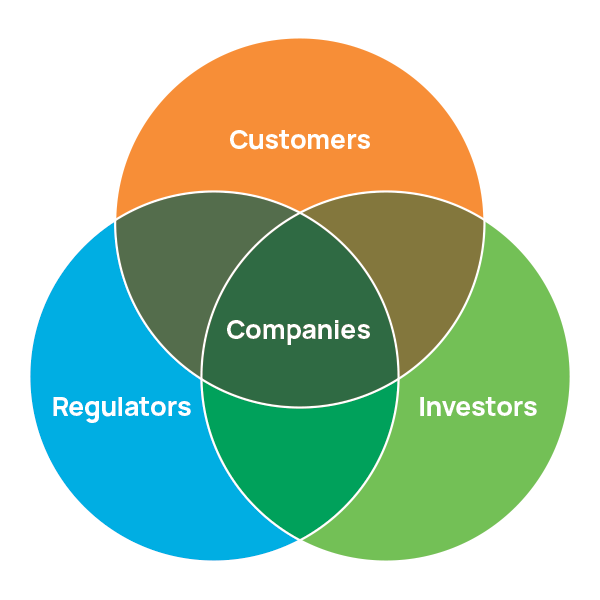As emissions reporting becomes ever more important, so does choosing a GHG software that meets all your strategic and operational objectives.
The United States Environmental Protection Agency (US EPA) began regulating greenhouse gas (GHG) emissions under the Clean Air Act over a decade ago. Combined with the mounting climate crisis and new heat records seemingly set every month, companies are coming under increasing pressure to reduce their GHG outputs.
Business investors are critically analyzing how companies are addressing the environmental, social, and governance (ESG) aspects of doing business. The consumer public is also now more informed than ever on which companies are paying sufficient attention to these issues, and are increasingly likely to withdraw their purchasing support from those whose performance they deem unsatisfactory.
For organizations, employing technology solutions that satisfy stakeholder groups and their ESG-related requirements has thus become imperative. With multiple GHG software solutions on the market, however, it can be confusing to discern what functionality is important and will meet common business needs.
Here then, are five functionality criteria that we believe GHG software needs to meet.

1. Visual data analytics
The ability to compare emissions data with organizational compliance requirements and sustainability reporting goals is paramount in tracking performance, and an effective way of doing so is via visual data software dashboards.
An array of flexible and customizable dashboards can provide valuable insight into your GHG emissions data, enabling you to immediately assess your performance, spot weaknesses, identify trends, and work towards increasing the effectiveness and efficiency of your emission controls.
2. Calculation capabilities
A highly useful feature included in some GHG emission management software is a calculation tool designed to assist users to quantify their annual greenhouse gas (GHG) emissions. A key consideration here is possessing the agility to cater for emission factor updates. A GHG calculation tool should ideally allow:
- Recalculation of existing monitoring records where calculations of past, present, and future data values are possible
- The use of different units of measure to cater for operations in different countries where units are not uniform
- Comparing targets and ‘actuals’ against industry standards and historical company performance
3. Integration with other internal system
Siloed data within different organizational departments can be a real problem, compromising the accuracy and completeness of the data, as well as an organization’s ability to access it quickly and timeously.
The ability to integrate GHG emissions software with other business systems is a valuable attribute, enabling companies to gather emissions data from various internal and external sources and aggregate it within one centralized system.
The effect of having an integrated GHG emissions software platform can be dramatic – faster data access, more complete information, higher analytics accuracy, and improved auditing processes are all potential benefits.
4. Notifications and reminders
Dealing with the demands of the modern business environment mean that it’s easy to get pulled away from keeping a close eye on your important emissions metrics.
It’s therefore vital that your GHG software should contain notifications to alert you to important information such as exceedances and non-conformances (such as breaching the Clean Air Act emissions tolerances for example), and even relevant upcoming compliance deadlines and related action reminders.
5. Efficient GHG emissions report generation
A large component of emissions management takes the form of disclosure ie. reporting on the quantity of GHG emissions produced by an organization as well as what actions are being taken to reduce and minimize this amount.
Without reporting, regulatory authorities are in the dark as to whether a company is meeting its compliance requirements, and investors are lacking information which will assist them to make strategic investment decisions.
With reporting being such an important part of the GHG emissions management process, it is vital that any potential GHG software makes the reporting aspect as efficient as possible.
One way of doing so is to have built-in reporting templates for globally recognized carbon emissions standards such as AP-42, DEFRA, and the GHG Protocol. Doing so eliminates confusion and complexity by providing companies with the exact metrics on which to report to achieve a high reporting standard.
Further useful functionality in this area comprises the ability to report on multiple ESG standards simultaneously. Some GHG software may include an indicator library which maps GHG data equivalencies across multiple standards, allowing users to avoid duplication efforts and input raw or normalized data just once, making the reporting process far quicker and more efficient.
Bonus feature: Multi-language functionality
Although not a ‘must-have’ feature, GHG software that is available in several languages and/or offers text translation is a useful feature for those companies which have sites or businesses operations spread across countries where predominant languages may differ.
Users are more likely to adopt and use a system, as well as enter information more accurately if they can do so in their native language. Training times may be reduced as well, enabling businesses to get their employees up-and-running faster and reducing the amount of time required to start benefiting from using the software.
Frequently asked questions (FAQ)
What are the 3 components of ESG benchmarking?
- Environmental – Focuses on the different impacts a company can have on the environment such as GHG emissions, energy and water usage, dealing with waste, etc.
- Social – Focuses on the company’s relationship with its employees, customers, partners, and the public
- Governance – Focuses on compliance, ethical and legal standards, and transparency within the company
What is sustainability benchmarking?
Much the same as ESG benchmarking, it consists of evaluating how sustainable a company’s operations are across a range of criteria to identify areas of improvement, track progress, and gain insights into how well its managing its environmental and social impacts.
Who can ESG benchmarking be performed by?
ESG benchmarking is usually performed by ESG consultants and specialist ESG rating agencies, but can also be conducted internally by companies themselves.

